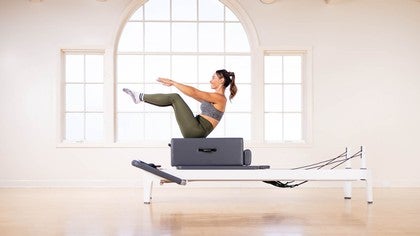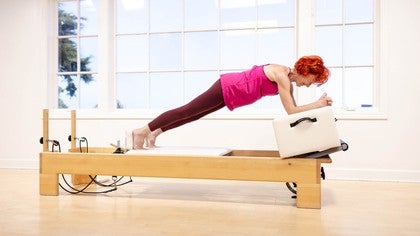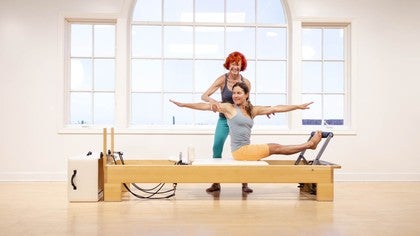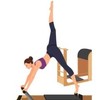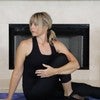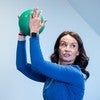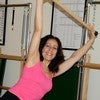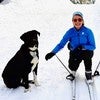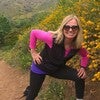Description
About This Video
Transcript
Read Full Transcript
Hi. I'm Courtney Miller, and I am so excited to be back on Pilates anytime. Today, I'm going to take you through what I would call a foundational reformer workout. That doesn't mean it's gonna be easy. There are some challenging moves that we will do in this class, but I've taken out any falling hazards. You're not gonna kneel on the machine or stand on the machine. So this is an awesome place to start. I have all of my springs on except for a yellow.
So for me, that's 3 reds in one blue, I want the tension to be heavy. We're also gonna be using the box today, so make sure you have that ready to go. Let's get started. Lying down on the carriage. Legs are draped over the foot bar.
We're gonna do some reformer roll ups, and I love this move because it connects movement to breath. So take a big breath in while here. On an exhale, you roll all the way up over your thighs, and I usually like to stay here for a little bit. Relaxing the shoulders, pulling the core back, reaching the crown of the head forward. Gonna call this a c scoop, and you'll see it come back again throughout the class. Breathe into your back and into your sides while you're in the c scoop, and then roll yourself all the way back to the mat.
Road, we're gonna do about 10 repetitions of each exercise. So if you're a counter, just stick to around 10. I like to inhale down and exhale up. So some of the things I think about when I do this move is connecting my spine to the mat during the roll up. Particularly my low back and connecting my spine to the mat during the rolled down. Inhale down, exhale up.
You'll notice in Pilates in in a lot of movement modalities. We use an exhale when we are challenged. Right? It's x hill with exertion is sort of the same. Inhale to lengthen. And then exhale when you need to hit that pedal to the metal and push through something that's challenging. 2 more, if your shoulders are coming up by your ears, just consciously let them drop down. And on this one, we're gonna stay up.
Maintaining the c shape with your spine, roll yourself back until your hands can be onto the foot bar. This next move is called a teaser prep. It's a preparatory movement for something a little bit bigger. The legs float off the bar, and this is somewhere you're more than happy to stay. In this position, I'm trying to pull my hips under. So I feel a lot of deep low core activation, but I'm also trying to open my chest and I can use the foot bar to help me do that by pushing down. When you're ready to take a balance, you let go, you reach, pull the shoulders back, and there's always the option to extend the legs.
When your legs go long, you're lengthening the lever. So it's more work on your core. This is a movement where you hold, but there's still a lot of work. We're holding for 4, 3, 2, and 1. Roll yourself to the mat. Take a break if you want.
I'm gonna stay up for our next move. This next move is called a series of 5. So it's 5 movements all in a row. No break. It's building endurance. First move. One leg straightens the other knee bends in. This is called single leg stretch.
You exhale when you switch. Big and complete exhale. So you wanna empty your lungs. In this series, I'm using my upper body to assist. So as I hug this knee in, I'm trying to lift a little bit higher to the thigh.
See if you can feel that. The higher you lift, the less you're gonna feel your neck. Take breaks if you want. The next move coming up is called double leg stretch. So I hug, scoop, I try to lift up higher, maintaining the shape, arms, and legs reach away. Exhale circle and hug.
This is almost like a break. When I pull my arms in and my chest up, I feel relief Right? It's not as hard because I'm using my arms to help me. This is where the challenge is, and then pull it all in. Let's keep going. Inhale to get big, exhale to get small.
One of the things I see a lot when I teach this move is that people look up when they reach back. Looks like this. Try to avoid doing that. Keep the chin tucks down and the shoulders lifted off the mat. Last two, Hug and hold for 1. This next move is scissors.
So hold behind your legs, extend your legs to the sky. Use your arm strength to find that lift. One leg drops low. Don't worry that the bar's there. That's not about the low leg.
Other leg stays high and you reach to the ankle. You're gonna leave your arms up and then kick towards that leg. Pull the leg to your chest two times. That's gonna stretch, and then switch. The breath sounds like this.
I'm trying to keep my arms up and kick towards them. Shoulders down, legs long. One more each side reaching high towards that ankle Bend your knees. You're not done yet. Hands go behind the head.
Straighten one leg. Rotate your body towards the knee that's bent. Exhales, you switch. So in our series of 5, this is the first move where we're adding rotation. That means we're challenging our stability on the mat. Particularly, the stability through your lower back and your pelvis. Use your hands purposefully.
Support your head shouldn't be feeling the neck here, curl up higher if you are. 3, 2, 1, one last move. Both legs go up, both legs drop down. I'm trying to aim for that foot bar, lift, and back up. To modify this movement, bend your knees, send them down, lift it up. 5, 4, the higher you scoop, the easier it is to maintain this shape. Right? So if you're getting tired, I encourage you to curl up higher, not drop down lower. One more time.
Feet go down, head goes down. This flow is really nicely designed because now you get to keep your head down for a while as we do footwork. I'm gonna start in what's called Pilates V. So my toes are on the bar, heels are together, toes apart. My knees are no wider than my shoulders. This is heavy tension. Push all the way out until your legs are completely straight.
So not kinda straight. Squeeze the inner thighs together. Just pause for a moment. I have a little bit of light underneath my back. I feel tight and connected through my front body and open through my hips.
Bend with purpose, push out ten times. Pilates is strength training. So if you don't feel that there's a lot of resistance and your muscles are working in peaking, I encourage you to add more weight. I want you once you get to number 8, 9, or 10 in your repetitions to feel the work. Pushing all the way out.
As I do this move, I'm trying to keep my ankles high as I push out my legs squeeze together so the backs of the knees connect last three, last two, last one, changing the position of the fee. Now I have my arches on. My feet and knees are together. Arch is on. I almost feel like I'm wrapping my toes. Like, my foot is now letter c. Push out to straight legs.
Ben to come in. You'll notice when you're working with springs that there's 2 directions of work. One is to push back and lengthen the spring. The other is to close or shorten the spring. And you're trying to resist in both directions, pushing and resisting in.
4, 3, 2, and 1. Changing my position of my feet. I go toes on, heels lifted high, zip up the inner thighs, keep the heels lifted, and push out. So we know that our standing posture, our dynamic posture is impacted by the alignment of our feet and ankle. So this is a time to wake up the feet, strengthen the ankles. It's also an opportunity to get your heart pumping, blood flowing.
You're working large muscles, heavy resistance, ankles and knees squeeze together. See if you can find that in your body, The next time we press out hold, heels will drop under. So I always say this spring tension can be used for good and for bad So where you might feel like it's heavy and it's challenging you, that resistance is also lengthening you. So I'm using those heavy springs to find a lot of length for my calf muscles. 10 calf raises, heels up, heels down, zipping the inner thighs together.
This is a good time to kinda check-in breath body connection when you exhale, do you exhale completely? Do you feel the ribs tightening? You know, you've got a left and right side of your core, so you wanna feel those two sides coming in and coming together. Last three, 2, one, bend your knees to come all the way in. Heels in the feet are gonna go onto the bar feet hip distance for a new move.
I always come down away from the shoulder blocks a bit when I do bridge. Now this is a lot of tension. I'm not pushing back. I'm focusing on lifting up. Let's do a hinge. So keeping my spine very stable and strong, exhale the hips lift up.
Inhale, hips go a little more than halfway down and exhale. Come back up again. 10 repetitions. My knees are staying over my toes. The cool thing about starting your pilates class this way is that the machine is supporting your men.
It's helping you to find alignment patterns that are gonna help you when you're up and you're standing. Knees over toes, easy to feel. Heels driving down into the bar, shoulders down and back. Arms active and long. The next time we're up, let's hold it.
And we're gonna do an articulation. So this is core work. Activating my upper abdominals, I'm gonna drop through my upper spine. Then activating through my middle abdominals, I'm gonna drop through my middle spine. Lower, and then release back to my start position, scoop to come up, and lengthen to lower down.
In addition to rolling up one bone at a time, I'm also trying to pull my hips towards that foot bar. So I feel longer in my spine, open in my chest, long in my neck, Here's a secret to doing bridge. If all your feeling are your hamstrings and not your glutes, you might not be lifting up high enough. So you wanna lift real high and actively squeeze the seat. The next time we're up in the bridge, we're gonna hold it. And we're gonna take a what I would call a single leg challenge or a weight transfer challenge.
So here I am. Both feet onto the foot bar. Keeping my pelvis as lifted and stable as I can. One leg extends up. Keep the foot pointed, so reaching out through your toes. Swing the leg low without dropping the hit and kick the leg up. Momentum is your friend here.
So you wanna get a nice little length. 3. 2, one. Now flex the foot, and you'll feel the difference. Right away, you feel the activation in your hamstring, length for your calf, repeat the kicks.
3, 2, One. Place the foot down. Check-in with your body. Do you need to reset? Still lifted, still level. Armstrong, Good. Let's do the same thing on the other side.
So opposite leg lifts, energy through my toes, hips stay in level, 5 sweeps, with the accent or the punctuation on that kick. 3, 2, 1, flex the foot. Down and up. 3, 2, 1. Place the foot down. And you get to roll down through that articulation that you practiced earlier one segment at a time. Good drape the legs over the bar, lift the arms. We're gonna through a reformer roll up, so tuck your chin all the way up. You go.
Take a stretch if you need to. See if you can keep your legs like this reach underneath and take off 2 red springs. So we are trying to maximize flow and efficiency in the class, see if you can get through that transition. I'm now on 1 red and 1 blue, rolling down, reaching behind my shoulders, and grabbing my loops. Hands go into the short loops for the 100. I'm gonna take you through 3 different variations for the 100 so you can choose what's best for you.
Begin with the hands over the chest. You've got tension to start. Flip the legs up. That's called tabletop when the knees are over the hips. On an exhale, the arms pull down the chest lifts up.
Option 1 is to hold this position and begin to pump the arms. Option 2 is to extend the legs, legs over the bar. Option 3 is to extend the legs, legs under the bar. So choose the option that you think's best for you and begin to pump your arms. The goal in this exercise is to coordinate breath and movement, inhale for 5 pumps, exhale for 5.
In 2, 3, 4, 5. Exhale. Shhh. The carriage doesn't move. The arms stay straight and the chest stays lifted. And just like we practiced before, if you're starting to feel tired in your neck, encourage you to curl higher versus lower down.
You're here for 10 sets of breaths, so you inhale through the nose, 5 pumps, you exhale through the mouth, 5 pumps, you repeat that ten times. We're pumping the arms to challenge our stability. So your carriage isn't bouncing or moving, and your body's staying stable too. One more set in through the nose. Now I always finish the hundred with a hold I try to deepen and then resist down.
This next exercise is literally called coordination, so it means it's gonna have some parts to it. Tuck your elbows into your sides and hover them off the mat. On an exhale, curl up and straighten your arms and your legs at the same time. I like to turn my legs out when I'm here. Chris cross your legs one over the other three times.
1, 2, 3. Bend your knees into your chest while holding the scoop. That's the coordination part. Bend your elbows and lower your head. Then repeat. So big exhale, curl up straight in the arms and legs.
Turn the toes out. 1, 2, 3, bend only your knees, and that's a chance to curl higher, bend your elbows, and lower your head. We're gonna do it two more times. So big exhale. 1, 2, 3.
Knees in. Scoop and fight for it. Reach to the fingertips. Elbows and head. Last time, 1, 2, 3, just the knees, curl curl, then the elbows and the head.
Well done. Let's do an inversion. So the feet will go into the long loops. This exercise is called short fine. If your headdress is up, go ahead and put it down. So an inversion is when we go upside down, and you're gonna get some assist, some help.
This exercise has a few parts to it, but each part is worth it. So number 1, starting with those low legs core tight, lift your legs up until you feel like your body's like in the letter l. And from here, you might feel a hamstring stretch. Now don't be tempted to fling yourself up. Instead, try to deepen the stretch. So now you feel the stretch in your hamstrings and in your lower back.
Your hips might come off the carriage a little bit, and the goal is to get the carriage to close or at least get as close to possible as closing. Then you roll up onto your shoulder blades with control. I don't have any weight onto my neck. My arms are strong. I bend my knees into a small diamond shape, so my knees are in line with my shoulders and my thighs are parallel to the ground.
Then I have to work to keep this shape as I roll down, just like we did in our articulating bridge, upper spine, middle spine, lower. Once I'm here, I press the legs out, rotate back to parallel, and the whole thing starts again. Let's go with a little more flow. Up to the l, deepen the scoop, roll to the shoulders, bend, and one bone at a time. Press out. Up to the l, deep in the scoop, roll up to the shoulders, bend, and feel like my hips are getting pulled away from my shoulders.
Two more times. Find the l. Deep it. Small bend. Don't make it too big. Roll down. Right through the center of your back.
Last time, you go up, you go stretch, you roll, bend, and Take it all the way down. Well done. Take your feet out of the straps. Hook those straps up behind you or onto your shoulder blocks. And it's your shoulder blocks. Let's get off the machine through a reformer roll up. So arms to the sky, you know what you love it.
You already practiced it. Exhill. All the way up, you go. Give yourself a nice squeezey hug and swing your legs off to one side. So that would be considered our warm up. We were lying down.
The machine was supporting us. We targeted a lot of areas in the body. Now we're gonna challenge our stability in a seated position. I took a blue off I'm left with 1 red spring. I'm gonna sit, so my legs are coming through the shoulder blocks, cross your ankles if you'd like, and you do wanna feel like this is heavy resistant. So if that one red's not enough, add another spring on. This first exercise is called plow.
You wanna sit really tall. If that means bending your knees, then bend them. We wanna focus on posture. Hands are just a little bit wider than the machine. I push back until my hands are behind my hips. Be mindful. You don't lean forward when you do that.
Let the arms come forward a little bit and then repeat. Each movement has its own evolution. Right? So what I want you to think about is finishing stronger than when you started. Because you're sort of building as you go. So sitting tall, finding that connection to core, finding that real time connection to body. Right? 3, pushing back with straight arms, straight wrists, 2, and 1. So that's your plow exercise.
Reach your arms forward and turn your palms up. Roll from your hips and get as low as you can maintain. When I'm down here, I'm actually thinking about my hundred position. Keeping the elbows high, I bend into a bicep curl position and straighten. Every time we work our arms, we wanna also engage our core, and the connection between the two is breath.
So if you breathe out when you bend your elbows in, you'll feel that compression and connection to your abdominal muscles. It's definitely challenging when you're working your arms to not overwork your neck. So if you're feeling any neck tension, drop your elbows a little bit. And keep on cruising. Inhale stretch, exhale curl.
3, 2, and one. Now straighten your arms all the way and turn your knuckles up. This next exercise is a single arm row. So I pull back with one arm and I look at the elbow, return through center. As I do this move, I'm trying to keep my legs as still as I can. I love doing this move before I go into our next exercise because this move helps to connect me to my back body. And I'm gonna knead my back body in the next one.
4, still on the scoop, looking towards the elbows it digs back, 3, 2, stretch coming up. You have to savor those moments in between the exercises. One more. Dive over your thighs. Take a stretch.
And hook up your loops when you're here. Okay. We're gonna come off the machine to one side. Our next exercise is called long stretch. Place your hands onto the bar and swing your inside leg onto the carriage. I'm placing my foot right where the headrest in the shoulder blocks meet, and then the outside leg comes to meet him.
So here I am in a plank position with the carriage closed. Let's just talk about this for one minute. Gravity is trying to push me down. So what I have to do in this position is push up against it. It's better to feel more scooped than it is to feel drooped in this movement. Taking your knees down as a modification.
I hold the shape and I push the shape back as far as I think I can stabilize. And then I bring my chest forward trying to close the carriage all the way. So two ways to modify this move. 1, take the knees to the mat, 2, increase your tension. So if you increase the springs right now I have a red. I could do it on a red and a yellow.
I could do it on a green. I could do it on a red and a blue. If I increase the resistance, I get more support from the machine. Push all the way out. And pull.
I just wanna remind you that this is a full body move. So if you're not feeling your legs, your inner thighs, and your seat, squeeze them one more time, big push all the way out, and pull all the way in. If your knees are down, take them up, step forward and lean back. So again, this flow is very well structured. Where you may have felt that exercise in your wrists. This next one is all lower body. So shift your weight back. You can let go. There's no weight in the arms.
Round back elephant, I wanna pull my ribs up and drop my head down. This is a preparatory movement to teach you how to do a pike. So really activate your core. I always lift my toes, and that helps me to keep my heels on the mat, pushing the carriage back as far as my heels can stay down. Tucking my chin and breathing out to bring the feet underneath me. Sounds like this.
Lekes are straight. No tension in the shoulders. Using my core to pull my feet underneath me and using my breath to find that big scoop in my spine. Last three. 2, 1, bring it in, and come on down.
So when it comes to Elephant, I always suggest don't overthink it. If you're feeling a stretch in the backs of your legs, you're good. Okay. So now we're gonna go into some upper body work. I'm sitting how I'm comfortable, which is my tailor position. If this isn't comfortable for you, You can change your legs or sit up on something.
I still have that one red spring on, and I have my shorter loops in my hands, which means this is definitely gonna be some resistance. I have to fight the sensation of the machine pulling me backwards. So I anchor my legs, I anchor my sit bones, And I feel like I'm sort of leaning towards the wind, just a slight subtle lean in my spine. First movement is offering. Reach your arms forward.
Shoulder height is perfect. Bring your elbows right into your sides. Push. Now, I have to feel connected to my lower body and to my core during this exercise. Chest is wide, palms, or level.
Adding on, reach forward, and hold. The arms can open as wide as you can stabilize, so don't let it pull you back. And then pull the arms back to your center and bend the elbows. Don't forget about the key I gave you earlier. You have a left and right side of your core.
So as the arms pull through center, I want you to think about those two sides coming together. And the connection there is breath. And in 2 more. Forward reach. Think of a letter t.
Stay stable. Bring it in. Forward reach. No tension in the neck. Bring it in and bring it down. Reach arms forward and overhead for shaving.
So in this exercise, I'm leaning for just a little bit more than the last elbows are wide. My gaze is at the spring, and I'm trying to keep my neck feeling long. Without letting my thumbs come apart, I straighten my elbows and then bring them back behind me. These movements that you're learning here, you're gonna see come up again in our later classes in our progression series. So I want you to take your time.
Focus on finding co contraction of the arms and abs. Because as soon as we take this to a kneeling position, you're gonna need that connection of arms and abs to help you stabilize. 3, 2, and 1, try circling your arms, and then hooking up those straps. Alright. Next move is a fun one, but I think they're all fun. Come on to your knees.
Your feet are gonna go against the shoulder blocks, and I want you to try to get your whole foot against. So, Sierra, my heel is right up against the shoulder block, These small little nuances will help you with some bigger moves down the road. So let's dial them now. Hands go to the bar, and I'm gonna find that same scoop that I was in in my round back elephant. Chin is down. This is a real intentional shape, so I don't feel like I'm taking a break. And then I'm gonna use the backs of my legs and my hips to push out into a plank, sort of like how we were for long stretch.
Looking up at the ceiling and widening my chest, I'm gonna bring the carriage in not by going forward but by lifting up. Press back to the plank, lift up to the extension. Press back to the plank, keeping the abs in. Trying to let those hips droop. One more like this, push out as far as you can.
Pull in. Sit the hips back and find that scoop. Let's repeat. Use the legs to push. Lengthen out. Bring it in look up. Send it back.
Bring it in look up. Send it back. A good rule of thumb is look wherever chest is pointing. So if your chest is pointing where the ceiling meets the wall in front of you, that's your gaze. Round the back. Let's do it one more time.
Use the legs to press. Find length. Pull it in. Pull it in. Up and wide is what you're thinking with the chest?
Connection into the glutes and heels. Last time. Send the hips back and reset. Well, then that exercise is called down stretch. Now we're gonna place our boxes on. So mine's over here at the back of the machine.
We're gonna use long box first. And in preparation for our next move, I'm gonna put this foot bar down. I still have my 1 red spring on. 1 red is what works for me on this flow, and you'll see there's ways modify the tension without changing the springs. So the right way to get onto this box is laying onto your stomach.
Place your hands onto the edge of the box and swing a leg over. Try not to come onto your knees, just straight down onto your abdomen. The position you wanna be in is one where you can drop your head all the way down to the headrest. If you're having a hard time connecting there, scooch forward a little bit. You'll hold the ropes as high as you want.
Just know that the higher you hold, the heavier it's gonna be. So I'm gonna go right about here to start. The last thing I want you to collect is your lower body position. There's 2 placements. One is legs together and lifted, pelvis into the box.
The other is legs apart and lifted. If keeping your legs together feels tight in your low back, just separate those legs. Here we go. The breath on this move is inhale to lift up and find the length. Acts hail to lower down with purpose. Inhale to lift up.
Exhale. I'm trying to keep my arms really close to the frame of the machine. And I'm trying to get my hands higher than my hips on the lift. And inhale down. 3 more. Maximizing movement of the spine is key in this movement. So As much as you are moving your arms, I want you to think you're also moving your back.
Big lift to come up and all the way down. 2. And then on the next lift, we're staying up. Hold. Bend your elbows to a ninety degree.
Think about keeping your elbows up and squeezed in. Leggs alive. 10 tricep kickbacks. But it's not just about the arms. Remember, we're training our body to co contract our abdominals every time our arms move. So when I straighten my elbows, I think belly button off the box. Whoo.
I use my breath to feel that. 4, 3, 2, and 1. Arms circles are next. So drop everything like you did earlier. Come on, off through that lift. Hold it as the arms open out to the sides, lower the chest, and lower the arms.
Lift up. This is a challenging movement. A lot of us have under trained our back body. So this is an opportunity to build strength in what's called the posterior chain, all those muscles behind you. Let's do 2 more circles.
And one more circle. Lift up. Open to a t. And drop it down. To get off the machine, take both straps in one hand and slide off the box. Okay. I wanna teach you an exercise, but I'm gonna teach it to you first without using the loops. This is a modified teaser position.
I want the carriage to stay pretty stable, so I'm gonna add a second spring on. So I have 2 reds, just so this thing doesn't wiggle around too much on us. You'll sit on the box. Here's what's really important. You need enough box behind you to lie down.
So scooch forward visualize yourself lying down and make sure that you have enough space. Reach your arms forward. And then just like we practiced our reformer roll up, and our foot bar teaser modified, roll the hips back, but keep the chest open. Feel free to place hands back if you'd like. Float the legs up.
This is a balanced move, not a power move. So from here, arms float down, arms lift up. Inhale down, exhale out. 3, you're gonna see we'll do this with the straps later. 2. So let's just roll through the move.
So we're ready. 1. Now the body's gonna move. So I roll my spine down onto the box. Head stays lifted. I'm almost in that hundred position.
And then I wanna feel my spine connect to the box as I roll back up. Roll down with control, reaching through the fingers will help, and roll up. Try to keep your legs as still as you can roll down with control and up. If you're having problems getting up, grab the backs of your legs. Use your upper body to help you, and then do your best to control the down.
You'll get stronger by controlling the down. Last time? Hold. We're making small circles with their arms 5, 4, 3, 2, 1, reverse, 5, 4, 3, 2, 1, and rest. So now you're ready to do it using the straps in the long box. That's gonna be another video though. Let's move on.
Turning the box into what's called short box. I'm gonna place my box over the shoulder blocks. This is what we're well for the configuration for me on the Allegro 2, you'll need to know your positioning for your machine at home. Take a seat. Feet come under.
I love this series because it's a great way to really feel your abdominals work without feeling your neck at all. If you do feel your neck, you might be down a little bit too low. So I sit tall with a little bit of space behind me on that box. I roll my hips back. And I feel tension into that foot strap. The lower you go, the harder you're gonna work, but be mindful. The sensation should feel like compression in the abdomen and not pushing forward.
Without changing your shape, just move the arms up and down. Lift and lower. It helps if you look at your toes and lower. For 3, 2. Now I want you to hold your arms up. Drop your chin towards your chest like you're doing round back elephant again, and then round over your thighs like we practice with the reformer roll up.
Rebuild the spine. Let's do it again. Roll back. Just the arms up and down. Big exhales finding that complete breath.
4, 3, 2, leave the arms, tuck the chin, scoop, take them all the way over, and then sit up nice and tall. But wait, there's more. So that's your round back variation. Your abdominals are working to scoop. We also have a flat back move, and my abdominals are gonna work to hold me.
Reaching your arms forward, I'm just gonna tilt my spine back. So leaning back, shoulders open. Lift the arms. This usually makes me shake a little bit, sit up really tall, and then lower the arms. So first I tilt Then I lift, then I rise, and then I lower. All of these moves that we're going through are great ways to strengthen the body, but they're also foundational movements that you're gonna see pop up in later classes, So it's good to really feel it now. Right?
One more time. Lean back. Think about the abdominals wrapping, lift up, pull it up, and send it down. Let's take a twist for our bow and arrow. So now one foot is underneath that strap.
Other knees bent in, resting on my hip. We're gonna start with a modified position. So I have elbow down. You could also do hand onto the floor, top handover head. The purpose right now is for you to find your alignment.
Shoulders stacked over shoulders. Hip, stacked over hip, and a sensation of connection to that lower side body. Leave the top arm stretched up, take the bottom handle around the chest, and the exhale as you lift. Inhale down, exhale lift. Tens your goal.
I want you to focus on moving the spine. Right? So get down as low as you can, lift up. The foot that's in the strap isn't gonna move. The hips, they're not gonna move. Inhale down and exhale up. 5, 4, 3, 2.
1, and you come all the way up to finish. Think about your arms being like a letter t. Stretch to the other direction, and let's do the other side. So turn around. Take a second and find your alignment.
Hip over hip, shoulder over shoulder, connection to that lower side. Your head is part of your your neck and head is part of your spinal alignment, so make sure that it's in line. Top arm goes overhead, bottom arm crosses, get low. When I lift up, I lengthen out. Down and up.
2, pushing up through the foot that's in the strap. 3, 4. Try not to twist. 5. 6 get lower, 7, 8, 9, come all the way up, and come all the way over. Cool. Okay. So this next movement is called swimming, and we're doing it on the short box to challenge our stability. So your pelvis goes centered on the box, and you wanna find a place where you can balance. It's gonna be a little bit different for everybody.
For me, I think of my belly button being right towards the middle of the box. Let's keep our hands on the rails. Find that leg lift. This is called a hip extension. My legs are apart, and my legs are externally rotated a little bit.
Turned out. It's gonna help me find my glutes. Before I start the movement, I wanna think about my pelvis pushing into the box And I've got 3 points of pressure. So my pubic bone and my hip bone on my left and my hip bone on my right, and they're pushing down. From here, I keep my pelvis pressing into the box and I start to flutter, kick my legs up and up and up and up and up. This is a glute exercise booty.
That's what you're feeling. Good? Okay. That's the leg part. From here, your arms extend forward, and your arms move in opposition to your leg. So if it's my left leg coming up, it's my right arm coming up. 109 87654321 hold it and rest it.
Good. That's an exercise you can do on the mat too, but it's a little bit more fun on the box. Alright. Let's put this guy back. So we're cruising through all of our moves. I think it's time to do another inversion. I have my 2 red springs on still.
Let's leave it. Lie down. Hands are gonna go into the long loops. And I'd like to be away from those shoulder blocks. Start with the hands over the chest.
Draw your legs up. Let's break this one down. The exercise is called overhead. So eventually our legs and our hips are gonna swing overhead. Not yet. Pull the hands down.
Push into the mat and practice lifting the hips up, and then controlling them down. So you can do 3 like this. I am absolutely pushing into my arms. It would be near impossible for me to lift up if I didn't have that connection to my core. Let's add on. This time as I extend my arms, I'm gonna extend my legs, lifting, and controlling down.
2, and 1. Now that's a great place to continue. If you're looking to add the inversion, follow along, it starts off the same. Except this time, my hips come overhead. No weight onto the head or neck, just like short spine.
Separate your legs about the width of your machine and flex your feet. So your legs feel active and strong. Roll your spine down, upper, middle, lower. Keep the legs low if you can. Lift the arms up.
And repeat. Don't forget to pull those arms down first. Then you can swing. Separate and flex. Roll it right down the middle of your back. Let's do 2 more. I use my back muscles to pull, complete breath to lift, lengthen down on the breath in, and last time.
Straight to the mat. Up and over we go. Separate flex. Look at your knees. You're looking for straight legs. Roll down, bend the knees in, feet go into the loops, long loops, leg circles are next.
The only thing I want you to focus on is keeping your pelvis as still as you can. Otherwise, you should feel freedom of movement. Unlimited movement potential, life is good, down and around and together. If you can get those legs to meet in center, beautiful. Up, open, down. Hips are level up, open, down.
One more. So your leg bone in your hip joint is a ball and socket joint. Reverse your circles if you haven't already. So this is a very intuitive movement. Should feel really good.
No restriction. Just grooving. 3. 2. 1. I like this next one because I feel like it kinda calibrates my brain. Find your turnout, bend your knees.
Keep your heels together and press straight out. These are your frogs. So I say the calibration comment because if you're pushing more with one side, it'll be really hard to keep the legs together. So you're thinking of that left to right abdominal, left to right leg relationship, left to right brain, everything's coming in through center, moving from the powerhouse, moving together in synergy, 3, 2, and 1, leave the legs straight and low for this one. Open your legs so that your straddle splits, flex your feet, and draw your heels together to touch.
So later on in our classes together, we'll be standing on the machine doing standing splits. I want you to visualize what that would feel like right now. So you're standing, pressing the carriage out, using your upper inner thighs to close. Big open. Big close. Last three.
Even though the feet are in the straps, you very much feel this movement coming from as close to your core as possible. 2, and 1. The feet come out of the straps. Feet can go down onto the platform. To come off the machine, let's do a formal roll up.
We've got one more move we're gonna do. I like to scooch my feet as far forward as I can. Arms up. Exhale. All the way over we go.
Alright. We're gonna finish with a push up. Very traditional to do this. Hands go down onto the mat. Feet step back. Find your shoulder over wrist alignment. Lean your fingert lean your weight, pardon me, towards your fingertips, and then take the whole shape of your body down.
Think chest to mat. And the next seals you push up. Our goal is 10, reduce the range of motion if you're feeling too much intensity, down and up. 9, 8, 7, 6, 5, shoulders are staying wide on the back, 4, head in line with spine, 3, 2, and that is 1. Reach down, touch your toes, take a moment, shake it off, rebuild your spine.
That was an awesome workout. So so many of the moves we did in this workout will help you through some of the more progression based flows. Those dynamic moves. So keep coming back to this class. You're gonna find awesome little tidbits, but it'll help with all of your other classes.
I'll see you soon. Bye.
Intermediate Reformer: 40-Minute Classes
Comments
You need to be a subscriber to post a comment.
Please Log In or Create an Account to start your free trial.
